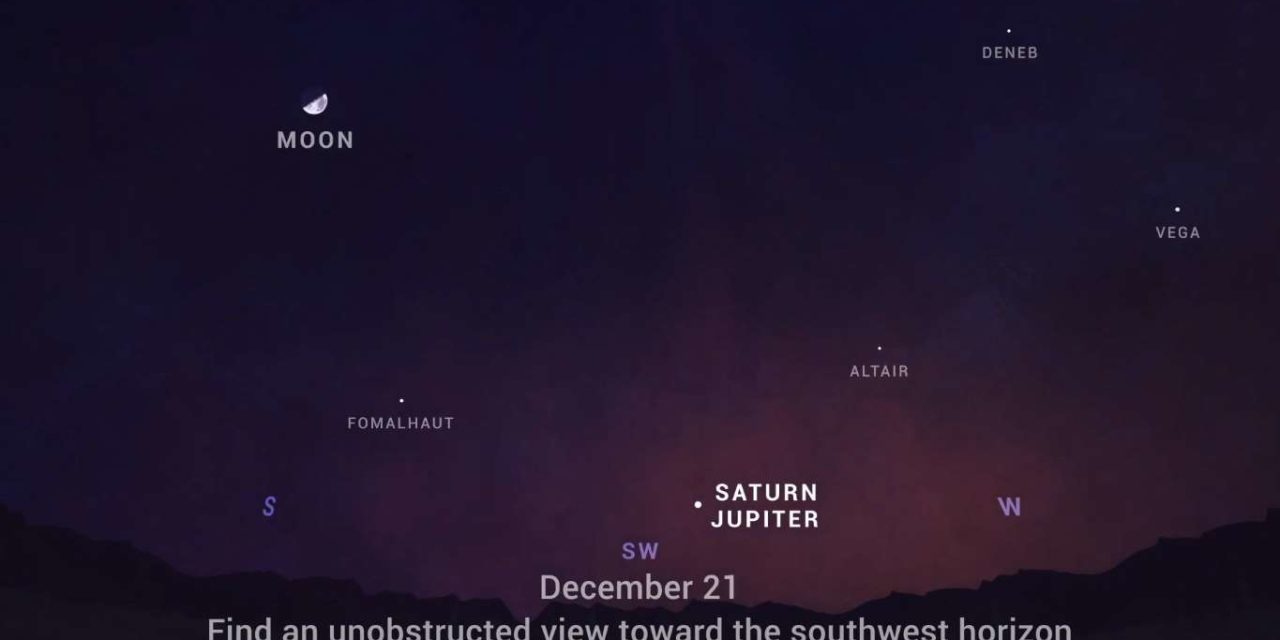Science and wonder are united in our night sky this holiday season. The first Christmas star in nearly 800 years will appear in our night sky the last weeks of December beginning on the Winter Solstice, Dec. 21. What is known as the “Christmas Star” is the alignment of two giant planets — Jupiter and Saturn — to create a radiant point of light that will look large because it is closer to earth than these planets normally approach.
NASA reports that these two largest planets in the solar system will come together in “a great conjunction” that hasn’t occurred since March 4, 1226. The alignment will appear in the southwest sky after dusk, looking like one large star beginning on the winter solstice, Dec. 21, 2020. The best way to catch a glimpse of the rare phenomenon is to look about one hour after sunset, according to NASA. The planets are visible with the naked eye.
“What has become known popularly as the ‘Christmas Star’ is an especially vibrant planetary conjunction easily visible in the evening sky over the next two weeks as the bright planets Jupiter and Saturn come together, culminating on the night of Dec. 21,” NASA said on its website. “Jupiter will look like a bright star and be easily visible,” adds NASA. “Saturn will be slightly fainter and will appear slightly above and to the left of Jupiter until Dec. 21, when Jupiter will overtake it and they will reverse positions in the sky.”
A few fun facts about the great conjunction according to Joe Rao, instructor and guest lecturer at New York’s Hayden Planetarium and the site Space.com:
- “We call it a ‘great’ conjunction because to ancient skywatchers, these were the two slowest moving planets in the sky; Jupiter takes nearly 12 years to describe a full circle in the heavens. It spends a year visiting each zodiacal sign in the sky. Saturn takes 29.5 years to make one full trip around the sun. Because of their respective slow movement, a conjunction or — to the ancients — a “celestial summit meeting,” was rather unusual. Such get-togethers happen about every 20 years on average.
- Some websites say it has actually been nearly 400 years since these two giants got this close, The last time these two planets appeared so close was on July 16, 1623, when they were only five arc minutes apart — that’s actually 397 years ago.
- Even though it looks as if they are merging during the “great Conjunction” they are actually still millions of miles apart.
- Some have suggested that these two planets might be a replica of the legendary Star of Bethlehem. Actually, one of the more popular theories for the “Christmas Star” was that it was a series of conjunctions between Jupiter and Saturn in the year 7 BC. In that single year, Jupiter and Saturn met not once but three times (in May, September and December).
The next time these two giant planets will come together to create a “Christmas Star” we won’t be around. According to calculations, these two planets will scrunch even closer together on Dec. 25, in the year 2874. How’s that for inclusion in “The Age of Aquarius?”
Featured image: The “Christmas Star” will be visible in the southwestern sky beginning Dec. 21, for approximately the next two weeks. Image MSN News.
Featured musical link: Age of Aquarius — Let the Sunshine in by the Fifth Dimension.








Recent Comments